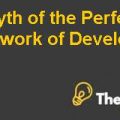GM Power train Case Study Case Study Solution
Historical Background
This case illustrates General Motors, a manufacturing company engaged in the production of automobile vehicles. However, the case specifically talks about the company’s Fredericks burg plant, which was one of the smallest plants acquired by GM. The plant was built in 1970 by Westinghouse, which was then acquired by GM in 1978. The plant was responsible for manufacturing a core component known as Torque converter clutches (TCC), which was responsible for marring automatic transmission with certain vehicles and trucks. Furthermore, Joe Hinrichs a 29 year old Harvard Business School MBA graduate, who took control Fredericks burg’s management in 1996 assessed the declining profitability of the plant and felt the need for change in its production processes and labor. Moreover, it was assessed that, the plant could produce 22,000 TCC per day of 26 different models.
Management Issues
The primary Issue is that, the manager appointed for its Fredericks burg plant was a young MBA graduate at 29 years old named Joe Hinrichs. It was assessed that Hinrichs had established strong relationships with union leaders, supervisors and employees who also acted as his internal information sources, enabling him to establish strong relations with them in the plant. Furthermore, Hinrichs had seen the need for change, attributed to the declining profitability of the plant. Therefore, Hinrichs was considering taking various change initiatives, in which, the traditional plant employs the method of assembly line, where one worker adds one piece to the final product and moving towards worker cells in which, each cell would be responsible for adding certain value to the production of the final products. Additionally, it can be evaluated that, the worker cell initiatives has been accepted by the union leaders and supervisor, attributed to the strong relation Hinrich had developed with them.
Competitive situation
It can be assessed that the competitive situation has elevated for the company as well as for its Fredericks burg plant inl ight of the recent boom in the automobile industry with respect to their usage and acceptance by the consumers’ available in the market. It had peak various investors’ interest attributed to the huge potential present in the automobile industries, the competitors had increased, causing the competition to raise in the market. Furthermore, in light of the current situation faced by the management with respect to the broken plant it can be evaluated that, if the company decides to close the plant all together, then this could have significant impact of the trustworthy relationship established between Joe Hinrich and the union leader and supervisors. Additionally, it would also cause significant protest in the company by these employees and could also increase the unemployment rate of the company.
GM Powertrain Case Study Harvard Case Solution & Analysis
Business Environment
It can be assessed that Hinrich has done an amazing job to propel the concept of change in the upper and lower hierarchy of the plant, which had enabled him to engage the workforce. By taking the union leader, supervisors and employees on board through trust, he had turned them into change agents. Furthermore, Hinrich gave the employees a chance to share their concerns regarding the changes being implemented in the plant and giving proper guidance or evaluating the needs for the change to the, so that, they could better understand the reasons behind the change initiative taken by the management and allowed them to better engage with the process of change. Moreover, Hinrich produced jobs for its existing employees that were being considered to be laid-off by the company, which increased the acceptance among the employees regarding the changes taking place in the plant and it could also minimize the job security concerns any employee had.The plant was responsible for producing a key component Known as TCC, which was mandatory for the marriage between its Automatic transmissions and various car and trucks. Therefore, in an attempt to maximize its plants profits the management decided to bring about change through business process re engineering or effective production process redesign, which would reduce the lead times between their worker cells and also mitigate unnecessary cells which would enable the management to reduce its cost. This, in turn, would increase its overall profitability. Moreover, it can be determined that the plant’s manager had a limited budget, which would be used to fix the broken machine and continue its production operations while minimizing the outsourcing costs incurred in the time of repair or replacement of the machine. Therefore, it can be evaluated that the plant’s manager need to meet the budget estimated for the repair or replacement of the plant, which would enable them to maintain or ensure the quality of the product produced from the machine.............
This is just a sample partial case solution. Please place the order on the website to order your own originally done case solution.










